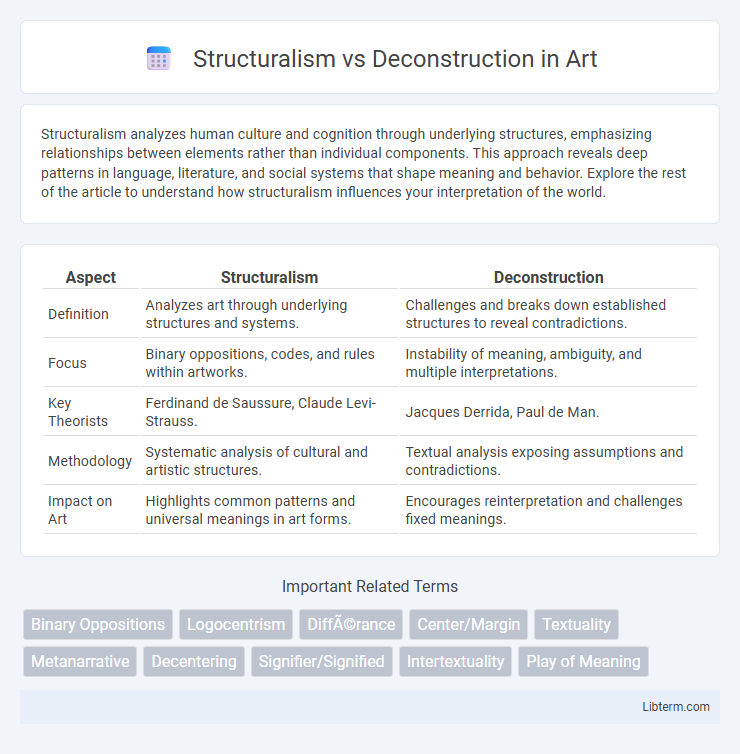Structuralism analyzes human culture and cognition through underlying structures, emphasizing relationships between elements rather than individual components. This approach reveals deep patterns in language, literature, and social systems that shape meaning and behavior. Explore the rest of the article to understand how structuralism influences your interpretation of the world.
Table of Comparison
| Aspect | Structuralism | Deconstruction |
|---|---|---|
| Definition | Analyzes art through underlying structures and systems. | Challenges and breaks down established structures to reveal contradictions. |
| Focus | Binary oppositions, codes, and rules within artworks. | Instability of meaning, ambiguity, and multiple interpretations. |
| Key Theorists | Ferdinand de Saussure, Claude Levi-Strauss. | Jacques Derrida, Paul de Man. |
| Methodology | Systematic analysis of cultural and artistic structures. | Textual analysis exposing assumptions and contradictions. |
| Impact on Art | Highlights common patterns and universal meanings in art forms. | Encourages reinterpretation and challenges fixed meanings. |
Introduction to Structuralism and Deconstruction
Structuralism emphasizes the underlying systems and structures that shape human culture, language, and thought, focusing on binary oppositions and the relationships between elements within these systems. Deconstruction challenges structuralism by revealing inherent ambiguities and contradictions in texts, arguing that meaning is unstable and context-dependent rather than fixed by structures. Both approaches profoundly influence literary theory, linguistics, and critical analysis by offering distinct methods for interpreting meaning and cultural phenomena.
Historical Background and Origins
Structuralism emerged in the early 20th century, rooted in the linguistic theories of Ferdinand de Saussure, emphasizing underlying systems and structures in language and culture. Deconstruction, developed by Jacques Derrida in the late 1960s, arose as a critique of Structuralism's fixed binary oppositions and sought to expose inherent contradictions and instabilities within texts. Both movements significantly shaped postmodern thought, influencing literature, philosophy, and critical theory by challenging traditional assumptions about meaning and interpretation.
Key Philosophers and Influences
Structuralism, pioneered by Ferdinand de Saussure and Claude Levi-Strauss, emphasizes underlying structures in language, culture, and society, heavily influencing linguistics and anthropology. Deconstruction, developed by Jacques Derrida, challenges these fixed structures by exposing inherent contradictions and ambiguities in texts, impacting philosophy, literary theory, and critical theory. Both movements critically shaped contemporary thought by questioning meaning formation, but Structuralism seeks stable systems while Deconstruction highlights instability and multiplicity.
Core Principles of Structuralism
Structuralism centers on the idea that human culture and cognition are understood through underlying structures, such as language, myths, and social systems, which govern meaning and behavior. It emphasizes binary oppositions and the interrelations of elements within a system, viewing these structures as universal and stable frameworks shaping human experience. Core principles include the belief that meaning arises from differential relationships between signs rather than from individual elements themselves, underscoring the importance of context within a closed structural system.
Foundations of Deconstruction
Deconstruction emerged as a critical response to Structuralism, challenging its assumption of fixed, stable meanings inherent in language structures. Rooted in the philosophy of Jacques Derrida, the foundation of Deconstruction lies in the idea that texts contain inherent contradictions and that meaning is always deferred through an endless play of differences, a concept Derrida termed "differance." This approach disrupts the binary oppositions foundational to Structuralism, revealing the instability and multiplicity of interpretations within literary and philosophical texts.
Structuralism: Approach to Language and Meaning
Structuralism views language as a system of interrelated signs where meaning arises from the differences between these signs rather than their intrinsic value. Ferdinand de Saussure's model of the sign, consisting of the 'signifier' (sound/image) and the 'signified' (concept), underpins this approach by emphasizing the relational nature of language. Structuralism seeks to uncover the underlying structures that govern cultural phenomena, asserting that meaning is fixed and stable within these systems.
Deconstruction: Reinterpreting Text and Meaning
Deconstruction challenges traditional structuralist approaches by emphasizing the fluidity and multiplicity of meaning within texts, exposing inherent contradictions and ambiguities. This method interrogates the binary oppositions that structure language and understanding, revealing how meaning is not fixed but continually deferred through linguistic play. By deconstructing texts, scholars unveil hidden assumptions and instabilities, transforming interpretation into an open-ended process rather than a quest for singular truth.
Major Differences Between Structuralism and Deconstruction
Structuralism analyzes underlying structures in language, culture, and literature by identifying stable binaries and universal patterns that shape meaning. Deconstruction challenges these fixed structures by exposing inherent contradictions and the instability of language, emphasizing that meaning is always deferred and context-dependent. While Structuralism seeks coherence through systematic frameworks, Deconstruction reveals the fluidity and multiplicity of interpretations within those systems.
Impact on Literary and Cultural Criticism
Structuralism revolutionized literary and cultural criticism by emphasizing the underlying systems and structures that govern texts, enabling critics to analyze literature through universal codes and binary oppositions. Deconstruction challenged these fixed structures, exposing inherent contradictions and the instability of meaning, thereby encouraging deeper scrutiny of language, interpretation, and power dynamics. This shift profoundly influenced contemporary criticism by promoting a more fluid understanding of texts and cultural phenomena, highlighting the multiplicity of meanings and the role of reader interpretation.
Ongoing Debates and Contemporary Relevance
Structuralism emphasizes underlying systems and binary oppositions shaping meaning, while Deconstruction challenges fixed structures and highlights textual instability and multiplicity of interpretations. Contemporary debates revolve around the applicability of Structuralist frameworks in the digital age versus Deconstruction's focus on the fluidity and fragmentation of meaning in media and literature. Scholars continue to explore their relevance in cultural studies, critical theory, and linguistics, particularly in understanding power dynamics and identity formation.
Structuralism Infographic

 libterm.com
libterm.com